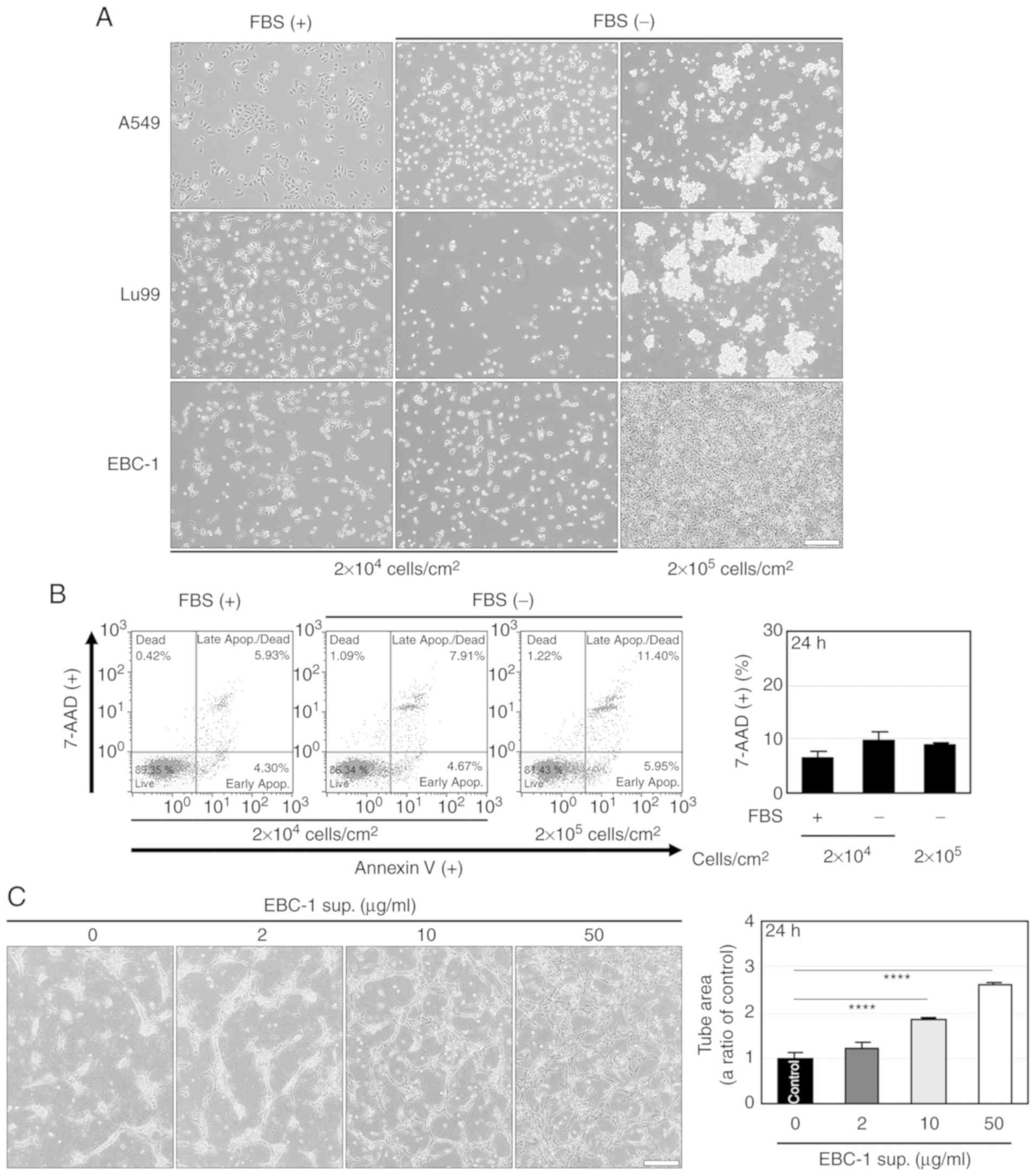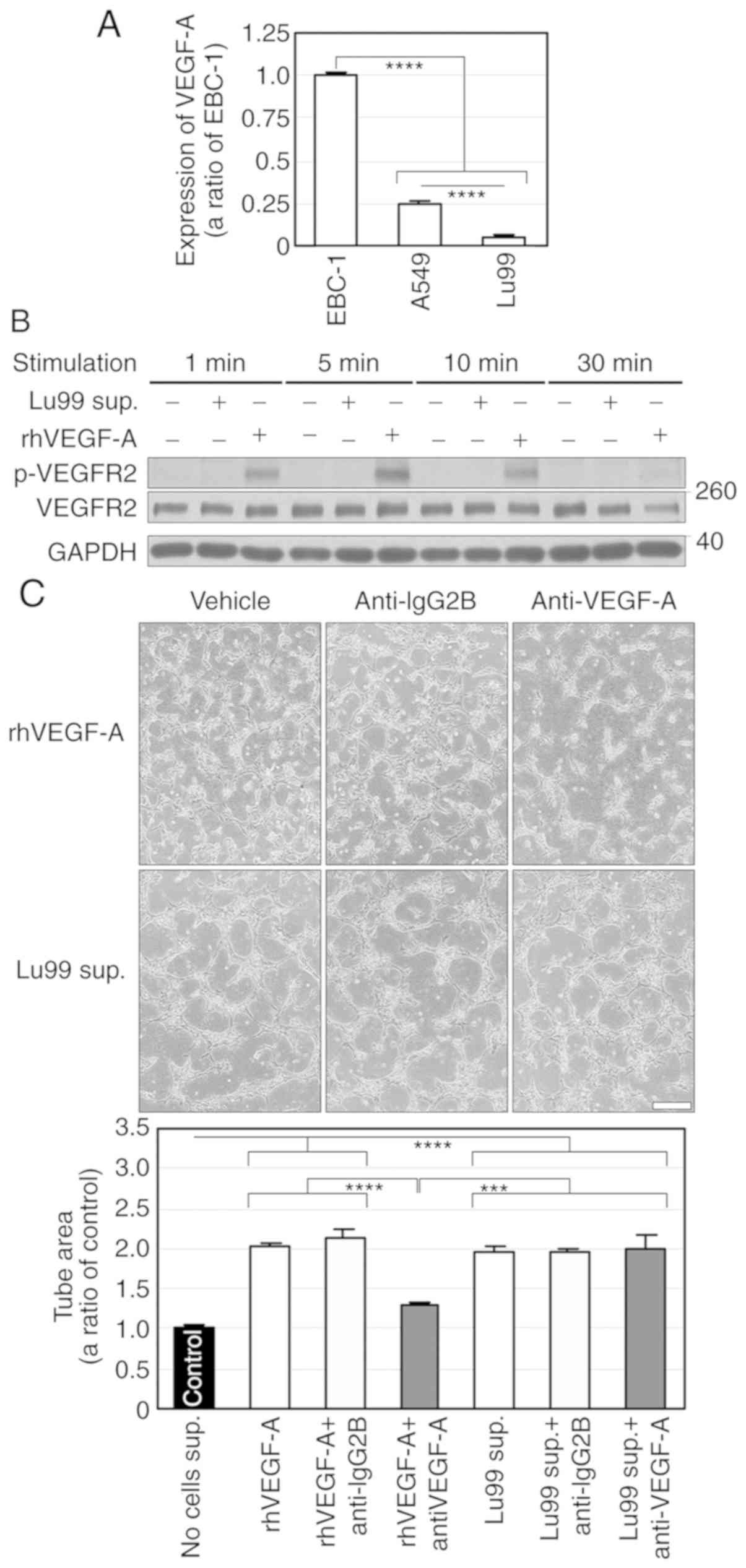|
1
|
Inoue M, Sawada N, Matsuda T, Iwasaki M,
Sasazuki S, Shimazu T, Shibuya K and Tsugane S: Attributable causes
of cancer in Japan in 2005-systematic assessment to estimate
current burden of cancer attributable to known preventable risk
factors in Japan. Ann Oncol. 23:1362–1369. 2012. View Article : Google Scholar : PubMed/NCBI
|
|
2
|
Siegel RL, Miller KD and Jemal A: Cancer
statistics, 2016. CA Cancer J Clin. 66:7–30. 2016. View Article : Google Scholar : PubMed/NCBI
|
|
3
|
Villaruz LC and Socinski MA: The role of
anti-angiogenesis in non-small-cell lung cancer: An update. Curr
Oncol Rep. 17:262015. View Article : Google Scholar : PubMed/NCBI
|
|
4
|
Hanahan D and Folkman J: Patterns and
emerging mechanisms of the angiogenic switch during tumorigenesis.
Cell. 86:353–364. 1996. View Article : Google Scholar : PubMed/NCBI
|
|
5
|
Dvorak HF: Vascular permeability
factor/vascular endothelial growth factor: A critical cytokine in
tumor angiogenesis and a potential target for diagnosis and
therapy. J Clin Oncol. 20:4368–4380. 2002. View Article : Google Scholar : PubMed/NCBI
|
|
6
|
Ebos JM and Kerbel RS: Antiangiogenic
therapy: Impact on invasion, disease progression, and metastasis.
Nat Rev Clin Oncol. 8:210–221. 2011. View Article : Google Scholar : PubMed/NCBI
|
|
7
|
Yoh K, Hosomi Y, Kasahara K, Yamada K,
Takahashi T, Yamamoto N, Nishio M, Ohe Y, Koue T, Nakamura T, et
al: A randomized, double-blind, phase II study of ramucirumab plus
docetaxel vs placebo plus docetaxel in Japanese patients with stage
IV non-small cell lung cancer after disease progression on
platinum-based therapy. Lung Cancer. 99:186–193. 2016. View Article : Google Scholar : PubMed/NCBI
|
|
8
|
Eguchi R, Nakano T and Wakabayashi I:
Progranulin and granulin-like protein as novel VEGF-independent
angiogenic factors derived from human mesothelioma cells. Oncogene.
36:714–722. 2017. View Article : Google Scholar : PubMed/NCBI
|
|
9
|
Livak KJ and Schmittgen TD: Analysis of
relative gene expression data using real-time quantitative PCR and
the 2(-Delta Delta C(T)) method. Methods. 25:402–408. 2001.
View Article : Google Scholar : PubMed/NCBI
|
|
10
|
Ung TH, Madsen HJ, Hellwinkel JE, Lencioni
AM and Graner MW: Exosome proteomics reveals transcriptional
regulator proteins with potential to mediate downstream pathways.
Cancer Sci. 105:1384–1392. 2014. View Article : Google Scholar : PubMed/NCBI
|
|
11
|
Bosque A, Dietz L, Gallego-Lleyda A,
Sanclemente M, Iturralde M, Naval J, Alava MA, Martínez-Lostao L,
Thierse HJ and Anel A: Comparative proteomics of exosomes secreted
by tumoral Jurkat T cells and normal human T cell blasts unravels a
potential tumorigenic role for valosin-containing protein.
Oncotarget. 7:29287–29305. 2016. View Article : Google Scholar : PubMed/NCBI
|
|
12
|
Keeley EC, Mehrad B and Strieter RM: CXC
chemokines in cancer angiogenesis and metastases. Adv Cancer Res.
106:91–111. 2010. View Article : Google Scholar : PubMed/NCBI
|
|
13
|
Chesney JA and Mitchell RA: 25 Years On: A
retrospective on migration inhibitory factor in tumor angiogenesis.
Mol Med. 21 (Suppl 1):S19–S24. 2015. View Article : Google Scholar : PubMed/NCBI
|
|
14
|
Thijssen VL and Griffioen AW: Galectin-1
and −9 in angiogenesis: A sweet couple. Glycobiology. 24:915–920.
2014. View Article : Google Scholar : PubMed/NCBI
|
|
15
|
Kadomatsu K, Bencsik P, Gorbe A, Csonka C,
Sakamoto K, Kishida S and Ferdinandy P: Therapeutic potential of
midkine in cardiovascular disease. Br J Pharmacol. 171:936–944.
2014. View Article : Google Scholar : PubMed/NCBI
|
|
16
|
Palma G, Barbieri A, Bimonte S, Palla M,
Zappavigna S, Caraglia M, Ascierto PA, Ciliberto G and Arra C:
Interleukin 18: Friend or foe in cancer. Biochim Biophys Acta.
1836:296–303. 2013.PubMed/NCBI
|
|
17
|
Funasaka T, Raz A and Nangia-Makker P:
Galectin-3 in angiogenesis and metastasis. Glycobiology.
24:886–891. 2014. View Article : Google Scholar : PubMed/NCBI
|
|
18
|
Bao C, Wang J, Ma W, Wang X and Cheng Y:
HDGF: A novel jack-of-all-trades in cancer. Future Oncol.
10:2675–2685. 2014. View Article : Google Scholar : PubMed/NCBI
|
|
19
|
Dai J, Peng L, Fan K, Wang H, Wei R, Ji G,
Cai J, Lu B, Li B, Zhang D, et al: Osteopontin induces angiogenesis
through activation of PI3K/AKT and ERK1/2 in endothelial cells.
Oncogene. 28:3412–3422. 2009. View Article : Google Scholar : PubMed/NCBI
|
|
20
|
Ramazani Y, Knops N, Elmonem MA, Nguyen
TQ, Arcolino FO, van den Heuvel L, Levtchenko E, Kuypers D and
Goldschmeding R: Connective tissue growth factor (CTGF) from basics
to clinics. Matrix Biol 68–69. 44–66. 2018. View Article : Google Scholar
|
|
21
|
He Z and Bateman A: Progranulin
(granulin-epithelin precursor, PC-cell-derived growth factor,
acrogranin) mediates tissue repair and tumorigenesis. J Mol Med
(Berl). 81:600–612. 2003. View Article : Google Scholar : PubMed/NCBI
|
|
22
|
Kermani P and Hempstead B: Brain-derived
neurotrophic factor: A newly described mediator of angiogenesis.
Trends Cardiovasc Med. 17:140–143. 2007. View Article : Google Scholar : PubMed/NCBI
|
|
23
|
Farhat FS, Tfayli A, Fakhruddin N, Mahfouz
R, Otrock ZK, Alameddine RS, Awada AH and Shamseddine A:
Expression, prognostic and predictive impact of VEGF and bFGF in
non-small cell lung cancer. Crit Rev Oncol Hematol. 84:149–160.
2012. View Article : Google Scholar : PubMed/NCBI
|
|
24
|
Ghassemi S, Vejdovszky K, Sahin E,
Ratzinger L, Schelch K, Mohr T, Peter-Vorosmarty B, Brankovic J,
Lackner A, Leopoldi A, et al: FGF5 is expressed in melanoma and
enhances malignancy in vitro and in vivo. Oncotarget.
8:87750–87762. 2017. View Article : Google Scholar : PubMed/NCBI
|
|
25
|
Nakamura H, Kambe H, Egawa T, Kimura Y,
Ito H, Hayashi E, Yamamoto H, Sato J and Kishimoto S: Partial
purification and characterization of human hepatoma-derived growth
factor. Clin Chim Acta. 183:273–284. 1989. View Article : Google Scholar : PubMed/NCBI
|
|
26
|
Everett AD, Narron JV, Stoops T, Nakamura
H and Tucker A: Hepatoma-derived growth factor is a pulmonary
endothelial cell-expressed angiogenic factor. Am J Physiol Lung
Cell Mol Physiol. 286:L1194–L1201. 2004. View Article : Google Scholar : PubMed/NCBI
|
|
27
|
Ren H, Chu Z and Mao L: Antibodies
targeting hepatoma-derived growth factor as a novel strategy in
treating lung cancer. Mol Cancer Ther. 8:1106–1112. 2009.
View Article : Google Scholar : PubMed/NCBI
|
|
28
|
Ren H, Tang X, Lee JJ, Feng L, Everett AD,
Hong WK, Khuri FR and Mao L: Expression of hepatoma-derived growth
factor is a strong prognostic predictor for patients with
early-stage non-small-cell lung cancer. J Clin Oncol. 22:3230–3237.
2004. View Article : Google Scholar : PubMed/NCBI
|
|
29
|
Iwasaki T, Nakagawa K, Nakamura H, Takada
Y, Matsui K and Kawahara K: Hepatoma-derived growth factor as a
prognostic marker in completely resected non-small-cell lung
cancer. Oncol Rep. 13:1075–1080. 2005.PubMed/NCBI
|
|
30
|
Zhao WY, Wang Y, An ZJ, Shi CG, Zhu GA,
Wang B, Lu MY, Pan CK and Chen P: Downregulation of miR-497
promotes tumor growth and angiogenesis by targeting HDGF in
non-small cell lung cancer. Biochem Biophys Res Commun.
435:466–471. 2013. View Article : Google Scholar : PubMed/NCBI
|
|
31
|
Ke Y, Zhao W, Xiong J and Cao R:
Downregulation of miR-16 promotes growth and motility by targeting
HDGF in non-small cell lung cancer cells. FEBS Lett. 587:3153–3157.
2013. View Article : Google Scholar : PubMed/NCBI
|
|
32
|
Guo H, Li W, Zheng T and Liu Z: MiR-195
targets HDGF to inhibit proliferation and invasion of NSCLC cells.
Tumour Biol. 35:8861–8866. 2014. View Article : Google Scholar : PubMed/NCBI
|
|
33
|
Thirant C, Galan-Moya EM, Dubois LG, Pinte
S, Chafey P, Broussard C, Varlet P, Devaux B, Soncin F, Gavard J,
et al: Differential proteomic analysis of human glioblastoma and
neural stem cells reveals HDGF as a novel angiogenic secreted
factor. Stem Cells. 30:845–853. 2012. View Article : Google Scholar : PubMed/NCBI
|
|
34
|
Enomoto H, Nakamura H, Liu W, Iwata Y,
Nishikawa H, Takata R, Yoh K, Hasegawa K, Ishii A, Takashima T, et
al: Down-regulation of HDGF inhibits the growth of hepatocellular
carcinoma cells in vitro and in vivo. Anticancer Res. 35:6475–6479.
2015.PubMed/NCBI
|
|
35
|
Bacic I, Karlo R, Zadro AS, Zadro Z,
Skitarelic N and Antabak A: Tumor angiogenesis as an important
prognostic factor in advanced non-small cell lung cancer (Stage
IIIA). Oncol Lett. 15:2335–2339. 2018.PubMed/NCBI
|
|
36
|
Akl MR, Nagpal P, Ayoub NM, Tai B, Prabhu
SA, Capac CM, Gliksman M, Goy A and Suh KS: Molecular and clinical
significance of fibroblast growth factor 2 (FGF2 /bFGF) in
malignancies of solid and hematological cancers for personalized
therapies. Oncotarget. 7:44735–44762. 2016. View Article : Google Scholar : PubMed/NCBI
|
|
37
|
Hu M, Hu Y, He J and Li B: Prognostic
value of basic fibroblast growth factor (bFGF) in lung cancer: A
systematic review with meta-analysis. PLoS One. 11:e01473742016.
View Article : Google Scholar : PubMed/NCBI
|
|
38
|
Hu MM, Hu Y, Gao GK, Han Y, Shi GL and Li
BL: Basic fibroblast growth factor shows prognostic impact on
survival in operable non-small cell lung cancer patients. Thorac
Cancer. 6:450–457. 2015. View Article : Google Scholar : PubMed/NCBI
|
|
39
|
Andersen S, Donnem T, Al-Saad S, Al-Shibli
K, Busund LT and Bremnes RM: Angiogenic markers show high
prognostic impact on survival in marginally operable non-small cell
lung cancer patients treated with adjuvant radiotherapy. J Thorac
Oncol. 4:463–471. 2009. View Article : Google Scholar : PubMed/NCBI
|
|
40
|
Wang S, Qin Y, Wang Z, Xiang J, Zhang Y,
Xu M, Li B, Xia Y, Zhang P and Wang H: Construction of a human
monoclonal antibody against bFGF for suppression of NSCLC. J
Cancer. 9:2003–2011. 2018. View Article : Google Scholar : PubMed/NCBI
|
|
41
|
La Venuta G, Zeitler M, Steringer JP,
Muller HM and Nickel W: The startling properties of fibroblast
growth factor 2: How to exit mammalian cells without a signal
peptide at hand. J Biol Chem. 290:27015–27020. 2015. View Article : Google Scholar : PubMed/NCBI
|
|
42
|
Sorensen V, Nilsen T and Wiedlocha A:
Functional diversity of FGF-2 isoforms by intracellular sorting.
Bioessays. 28:504–514. 2006. View Article : Google Scholar : PubMed/NCBI
|
|
43
|
Muller HM, Steringer JP, Wegehingel S,
Bleicken S, Munster M, Dimou E, Unger S, Weidmann G, Andreas H,
Garcia-Saez AJ, et al: Formation of disulfide bridges drives
oligomerization, membrane pore formation, and translocation of
fibroblast growth factor 2 to cell surfaces. J Biol Chem.
290:8925–8937. 2015. View Article : Google Scholar : PubMed/NCBI
|
|
44
|
Dimou E, Cosentino K, Platonova E, Ros U,
Sadeghi M, Kashyap P, Katsinelos T, Wegehingel S, Noe F,
Garcia-Saez AJ, et al: Single event visualization of unconventional
secretion of FGF2. J Cell Biol. 218:683–699. 2019. View Article : Google Scholar : PubMed/NCBI
|
|
45
|
Kanematsu A, Marui A, Yamamoto S, Ozeki M,
Hirano Y, Yamamoto M, Ogawa O, Komeda M and Tabata Y: Type I
collagen can function as a reservoir of basic fibroblast growth
factor. J Control Release. 99:281–292. 2004. View Article : Google Scholar : PubMed/NCBI
|



















